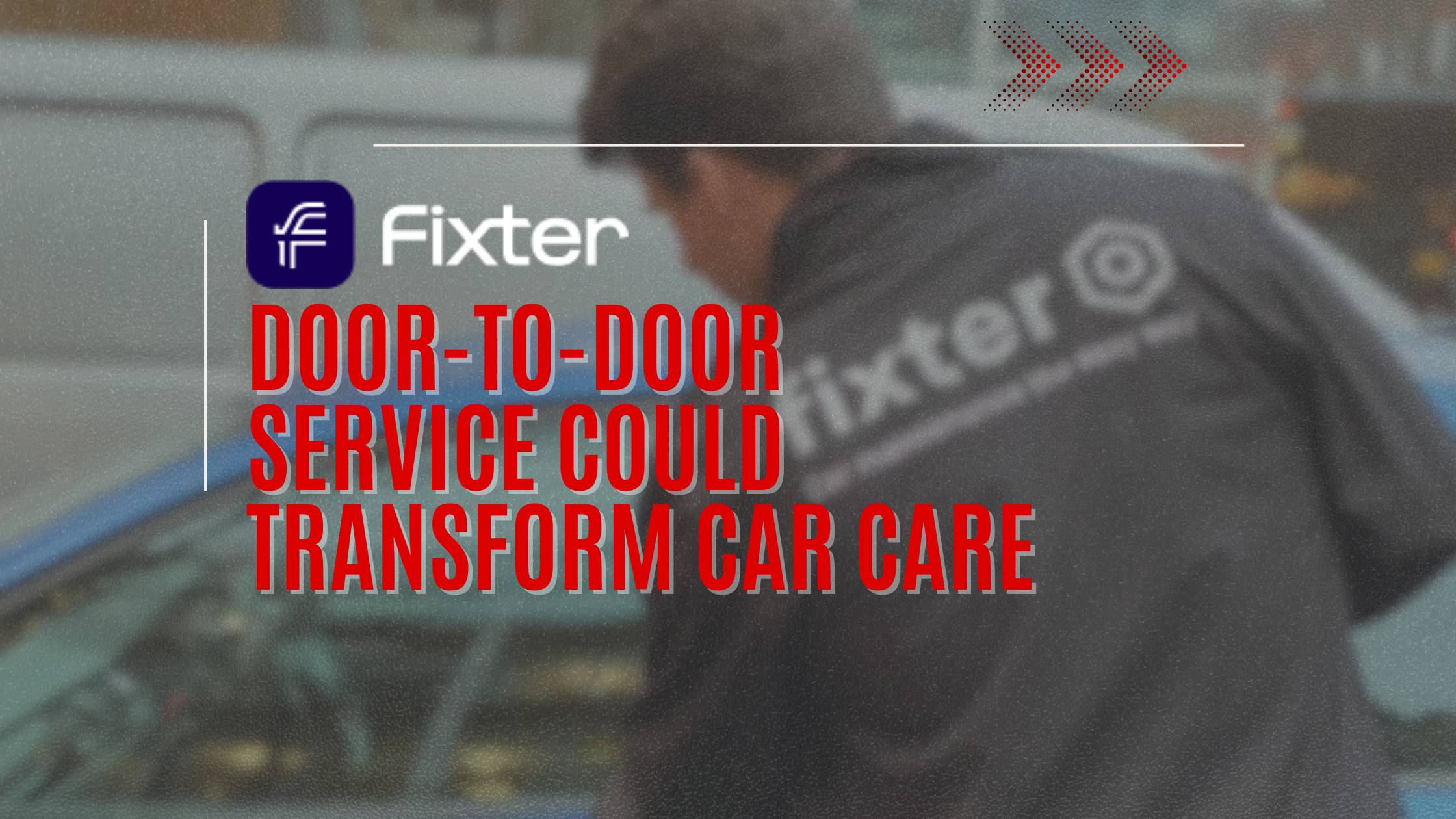Getting your car serviced has never been the highlight of anyone’s week. It usually means finding time during work hours, driving to a garage, waiting around—or arranging someone to pick you up—and hoping everything goes smoothly (and stays within budget). For many drivers, the entire process is inconvenient, unpredictable, and eats into their already packed schedule.
That’s where Fixter steps in with a fresh approach. Instead of you going to the garage, Fixter brings the garage to you—sort of. Their door-to-door car servicing model allows you to book online, have your vehicle picked up, serviced at a trusted garage, and returned, all without leaving your home or office. The result? A smoother, more transparent experience that fits neatly into daily life.
So the question is: Could this be the future of how we maintain our cars? With rising demand for convenience, digital booking, and time-saving services, Fixter’s model might be leading the way.
Why Door-to-Door Car Servicing Is Disrupting the Industry

Car servicing is no longer just about fixing problems—it’s about delivering convenience, transparency, and time savings. The rise of digital-first lifestyles has reshaped what people expect from everyday services, and car care is starting to catch up. Traditional garage visits, with their time commitments and unpredictability, are being replaced by a new model that’s built for modern life.
The Rise of On-Demand Services
We’ve grown used to convenience in nearly every part of life. Need a meal? It’s delivered. Shopping? A few taps and it’s on your doorstep. Even medical consultations can now happen over a video call.
This shift toward on-demand everything has created new expectations. Car servicing, once stuck in outdated processes, is finally entering that space. Services that collect your car, get it serviced, and return it—without you ever leaving your house—are aligning car care with how we live today.
Solving the Time Crunch for Drivers
Most people don’t have a spare morning to sit in a garage waiting room. Between tight work schedules, school runs, and other daily demands, making time for car servicing is rarely convenient.
Door-to-door solutions are removing that pressure. The car is picked up from your driveway or office, serviced at a trusted garage, and returned when it’s ready. You keep your day intact—and your car gets what it needs.
This model is especially helpful for:
- Commuters with long hours
- Parents juggling busy routines
- Professionals who can’t afford disruptions
The Transparency Consumers Want
One of the biggest frustrations with traditional garages is the lack of visibility. Pricing can feel vague. Timelines are unclear. And there’s often little communication between drop-off and pickup.
Door-to-door services take a different approach, offering:
- Upfront pricing with no hidden costs
- Live updates so you know where your car is and what’s being done
- Clear communication from booking to return
This kind of transparency builds trust and gives drivers confidence in the service—something many garages have struggled to provide.
How Fixter’s Service Model Works in Practice
Fixter transforms the car servicing experience by handling everything for you—quietly, efficiently, and without disrupting your day. From booking to return, every step is designed to be smooth and stress-free. If you’re curious how this kind of service fits into the bigger picture of modern car care, have a look at Exploring the Full Range of Services in Modern Car Care. So, what does that actually look like in practice?

Booking and Pickup Made Easy
It all begins online. Booking a service through Fixter is designed to be fast and completely hands-off. The process follows four clear steps:
- Enter your car details
Start by entering your registration number on Fixter’s website. - Choose your service
Select from MOT, full or interim servicing, or specific repair needs. - Pick a collection time
Choose a convenient time slot for pickup—at home, the office, or wherever you’ll be. - Let Fixter handle the rest
A fully insured driver arrives on time to collect your vehicle. The handoff is simple and professional.
You don’t need to call a garage, rearrange your day, or leave your front door.
What Happens Behind the Scenes
Once your car is collected, it’s taken to one of Fixter’s trusted partner garages. These are not just local options—they’re carefully vetted for service quality, reliability, and customer care.
Fixter keeps you updated along the way. You’ll receive notifications as your car moves through each stage of the service, and if anything unexpected comes up, they handle the back-and-forth with the garage for you. That means no calls to chase progress, no last-minute surprises—just smooth coordination behind the scenes.
Delivery and Final Check
When the work is complete, your car is delivered back to your selected location. Before drop-off, everything is double-checked for quality and completeness.
You also get:
- A 12-month warranty on all parts and labor
- Full transparency on the work completed
- A car returned in proper shape—ready to drive
Who Benefits Most from This Model?
Fixter’s door-to-door approach isn’t just a modern convenience—it solves real, everyday problems for different types of drivers. From busy professionals in the city to companies managing multiple vehicles, the model adapts to lifestyles that don’t have time for traditional car care routines.
City Drivers with Limited Time
Living in a city often means tight schedules, limited parking, and zero patience for waiting rooms. For urban drivers, Fixter’s model removes the need to plan around a garage trip. You stay focused on your day while your car gets the care it needs in the background. It’s ideal for those who need things handled without friction.

Businesses and Fleets
Managing more than one vehicle adds layers of logistics—and cost. Fixter simplifies fleet maintenance by coordinating pickups and servicing across multiple cars, saving admin time and reducing downtime. For delivery companies, field teams, or any business that relies on transport, this model streamlines operations without cutting corners.
Everyday Drivers Who Hate Garage Visits
Not everyone has the time—or the interest—to deal with traditional garages. If you’d rather avoid the calls, queues, and confusion that usually come with car servicing, Fixter takes it off your plate. It’s perfect for drivers who value convenience, clarity, and a process that just works.
This model isn’t just for one kind of driver—it’s built for anyone who’s done wasting time at the garage.
Potential Challenges and Questions
As convenient as door-to-door car servicing may be, it’s natural for people to approach it with questions. Not everyone is immediately comfortable with someone else taking their car, and assumptions about cost or access still shape first impressions. These concerns are valid—and worth addressing directly.
Trust and Transparency
Handing your vehicle over to a service you don’t visit in person can feel like a big leap. The lack of a face-to-face interaction often raises questions about safety and accountability.
To counter that, Fixter puts clear safeguards in place:
- Drivers are fully insured and background-checked
- Every collection and return is tracked in real-time
- Updates are shared throughout the process
- Clear documentation confirms what’s being done
This approach aims to build confidence by replacing physical presence with digital visibility.
Price vs. Perceived Value
There’s a strong assumption that added convenience means a higher cost. But that doesn’t always hold up in practice.
Services like Fixter often work with vetted independent garages—not dealership chains—which allows them to keep prices competitive. You see the cost upfront, you avoid last-minute fees, and in many cases, it’s less than what you’d pay at a main dealer. The model doesn’t just save time—it can also challenge the idea that convenience must cost more.
Availability and Coverage
This service model is expanding, but it’s not everywhere yet. In most cities and larger towns, coverage is strong and pickup slots are flexible. But in rural or remote areas, availability may be limited.
It’s a gradual rollout. As demand increases, more postcodes are added. For now, it works best in areas where infrastructure supports quick turnaround and higher usage.
Not all concerns disappear overnight—but the model continues to adapt.
The Bigger Picture—Where Car Care Is Heading
Door-to-door servicing isn’t just a short-term convenience—it reflects deeper changes in how people interact with services. Across industries, the shift toward digital tools, remote solutions, and streamlined access is reshaping what customers expect. Car care is beginning to follow suit. The Fixter model fits into a larger trend of turning time-consuming responsibilities into efficient, on-demand experiences.
A Digital-First Future
Across almost every service sector, consumers expect digital tools to simplify their lives. Booking, tracking, and managing everything from bank accounts to grocery deliveries is done through apps or websites—and car servicing is being pulled in that same direction.
For many drivers, having to call a garage, negotiate over the phone, or wait around for updates feels outdated. Digital-first car servicing provides the clarity and control people now expect as standard. The tools exist. The demand is already there. The industry is finally catching up.
From Ownership to Management
Not long ago, maintaining a car meant knowing how to check your oil, top up fluids, or even change brake pads. Today, that’s shifted. Fewer people perform maintenance themselves, and most would rather not interact with a garage unless they have to.
Instead, there’s a growing preference for managing car care like any other recurring service—book it, track it, and let someone else handle the details. This shift reflects how people treat their time: it’s less about control over the task, and more about control over the experience.
Sustainability and Efficiency

The move toward remote servicing isn’t just about ease—it can also be more efficient. Fewer individual trips to garages reduce overall vehicle movement, which means:
- Less fuel burned for maintenance-related travel
- Fewer short-distance, engine-cold drives that increase emissions
- More coordinated scheduling between garages and drivers
As this model grows, the potential environmental benefits become part of the conversation. It’s a small shift—but one with scalable impact.
Conclusion
Door-to-door car servicing addresses a problem that’s been around for years: how much time, effort, and guesswork it takes to maintain a vehicle. By removing the need to visit a garage, streamlining the process, and providing clear communication throughout, this model offers a practical solution that fits how people live and work today.
Fixter’s approach isn’t just about convenience—it reflects a larger shift in what customers now expect: digital access, time efficiency, and transparency. It answers a modern problem with a modern structure.
This isn’t just a passing trend. As more drivers look for ways to manage essential tasks without disrupting their routine, models like this may become the new baseline.




